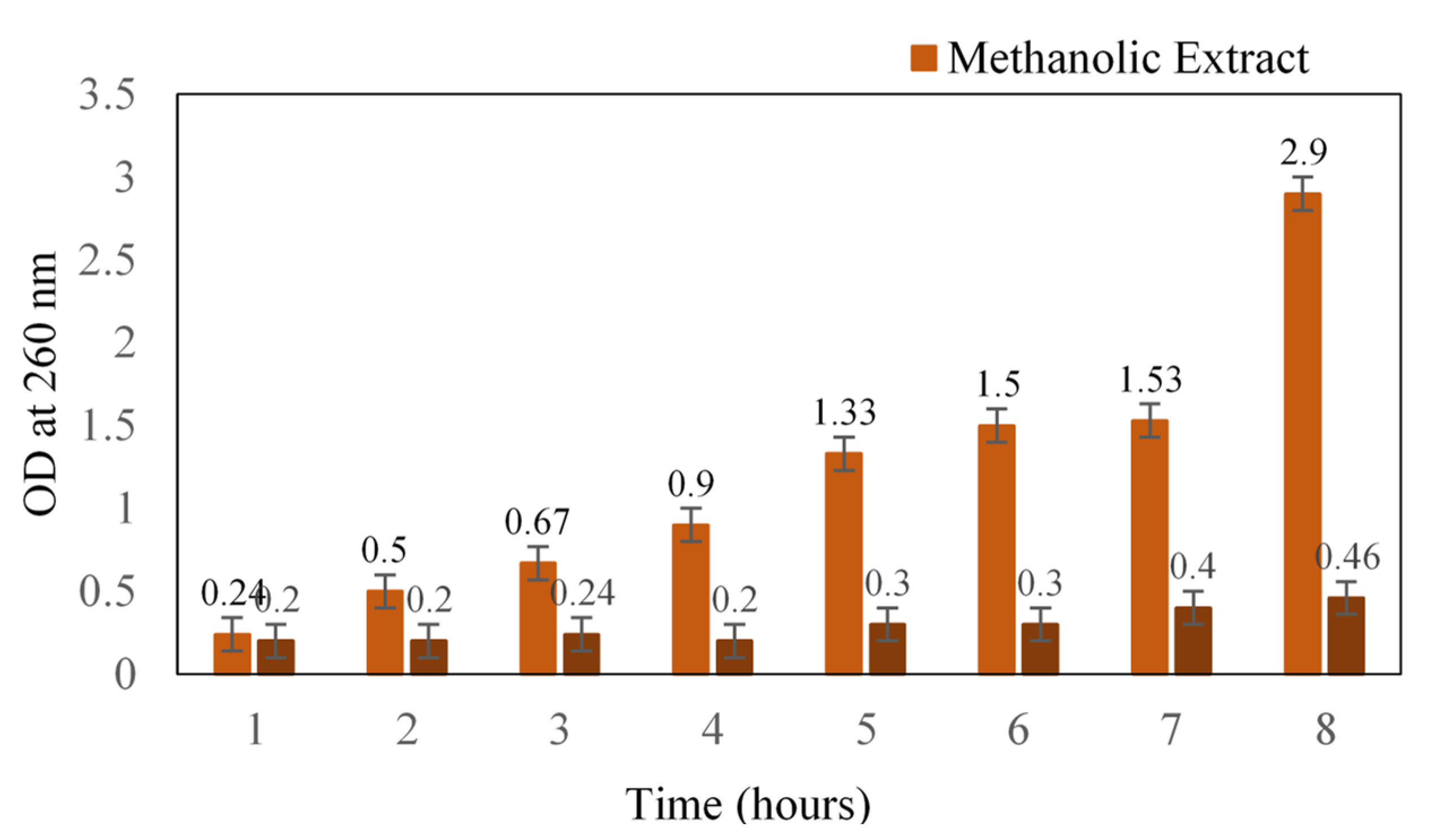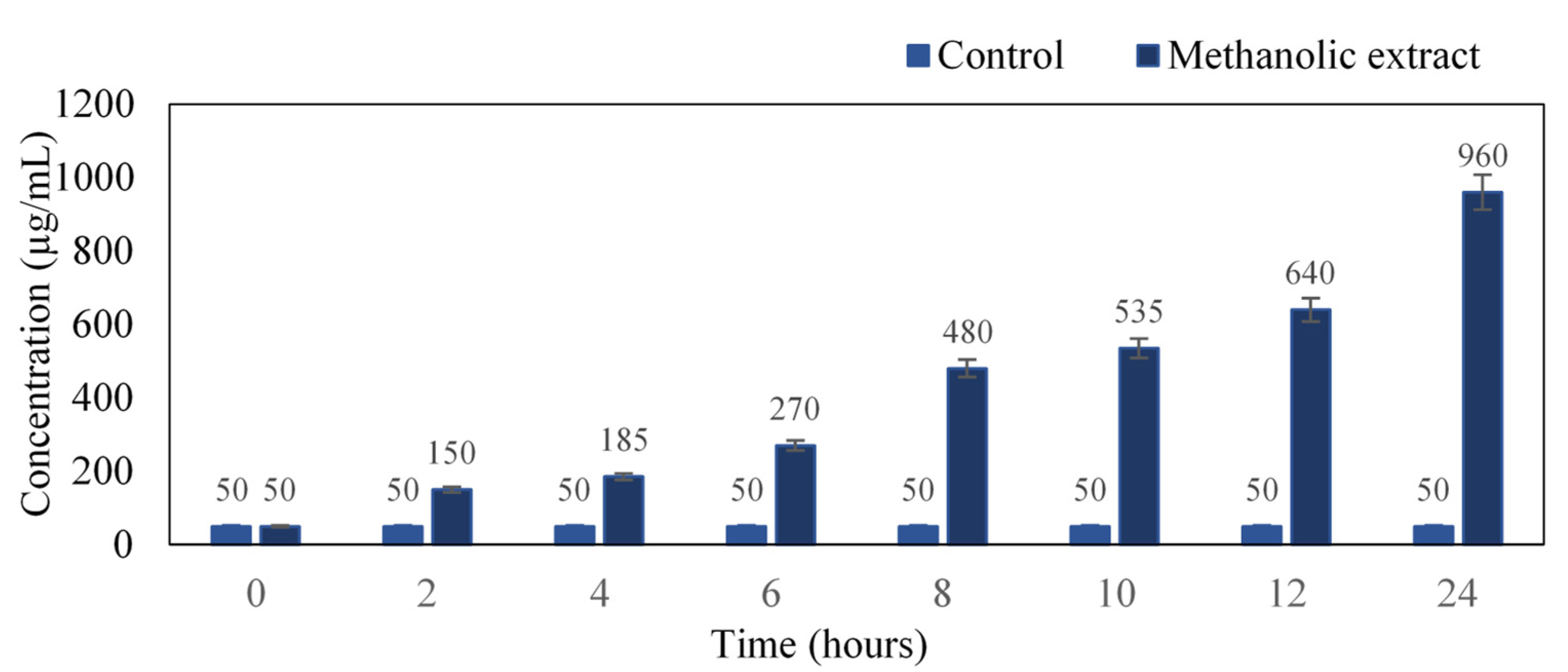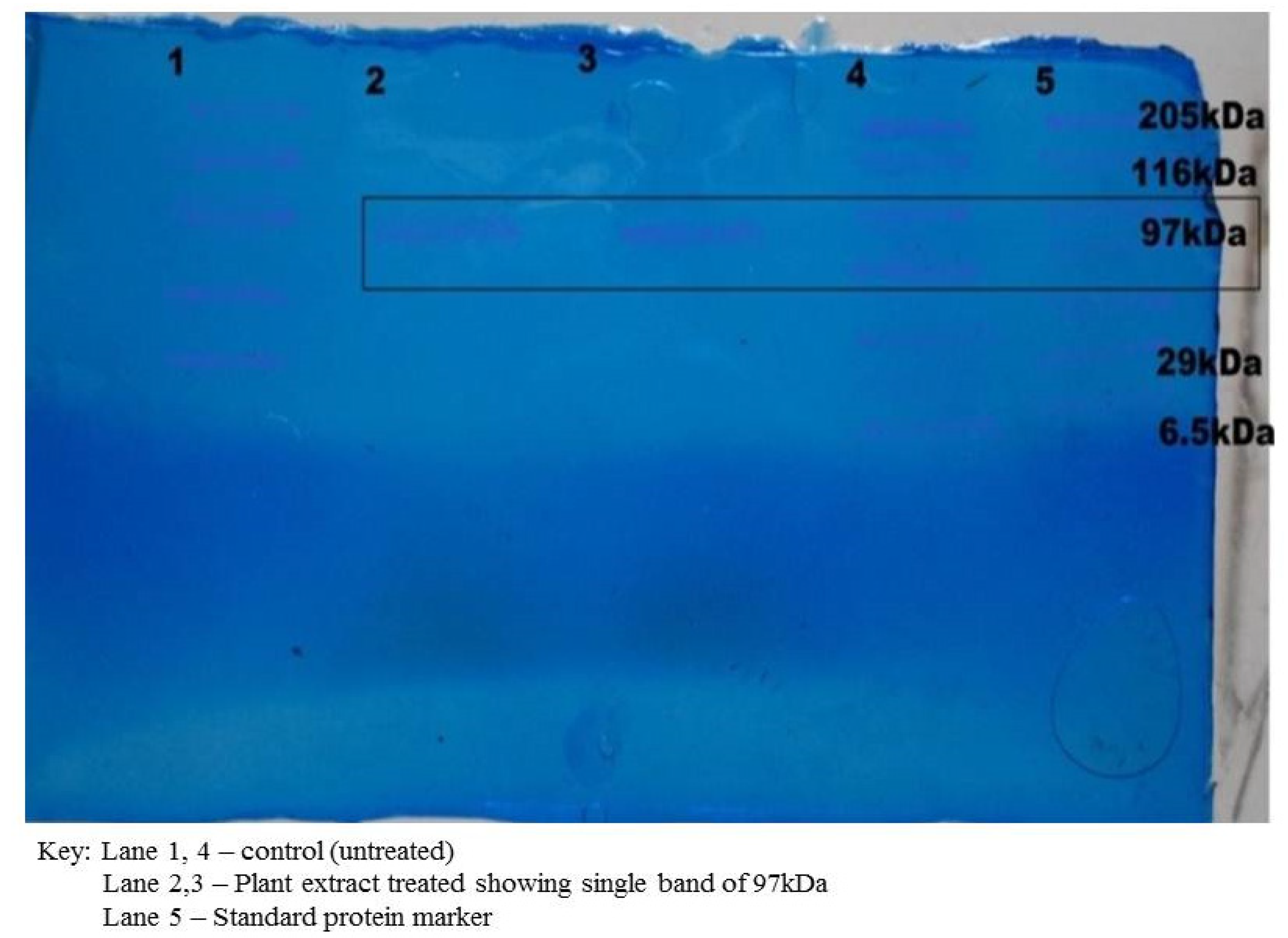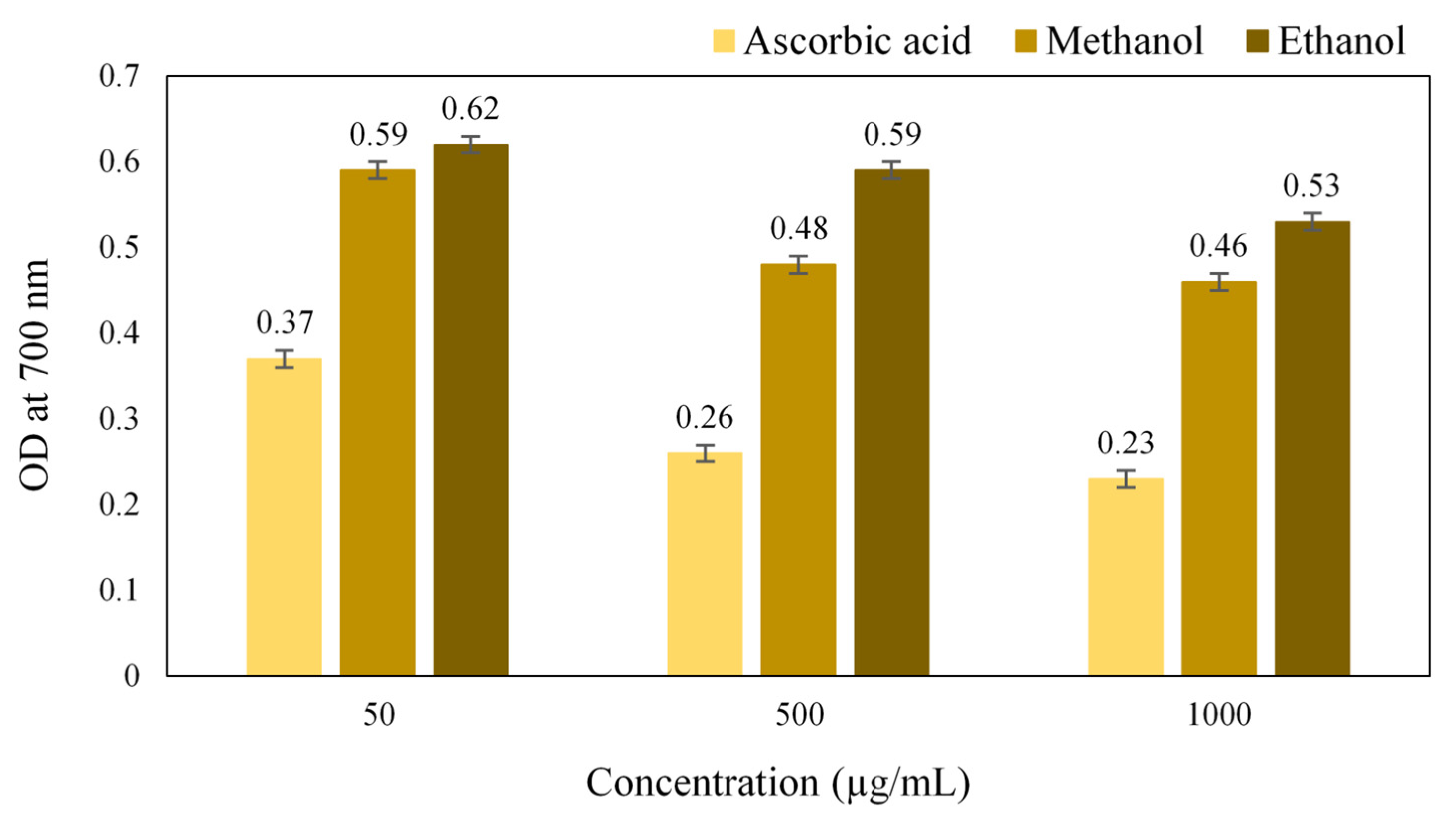Broad-Spectrum Antimicrobial, Antioxidant, and Anticancer Studies of Leaf Extract of Simarouba glauca DC In Vitro
Abstract
:1. Introduction
2. Results and Discussion
2.1. Phytochemical Screening of Plant Extract
2.2. Antimicrobial Activity of Plant Extract
2.3. Minimum Inhibitory Concentration (MIC)
2.4. Mode of Action of Methanolic Extract of S. glauca towards Staphylococcus aureus
2.5. Scanning Electron Microscopy
2.6. Estimation of Protein Content
2.7. Isolation and Analysis of Bacterial Proteins by SDS PAGE
2.8. Synergism Test by Checkerboard Method
2.9. Isolation and Identification of Bioactive Compound through Column Chromatography and Its Antibacterial Assay
2.9.1. FT-IR Analysis of Column Fraction
2.9.2. Gas Chromatography–Mass Spectroscopy
2.9.3. Analytical TLC of Column Fraction
2.9.4. TLC Bioautography
2.10. Antioxidant Activity of Simarouba glauca Extract
2.11. Anticancer Activity of S. glauca Extract
3. Materials and Methods
3.1. Collection and Preparation of Plant Extracts
3.2. Phytochemical Screening
3.3. Antimicrobial Activity of Plant Extract
3.3.1. Screening of Antibacterial Activity
3.3.2. Screening of Antifungal Activity
3.3.3. Minimum Inhibitory Concentration (MIC)
3.4. Mode of Action of Methanolic Plant Extract on Staphylococcus aureus
3.4.1. Test for Loss of Cellular Content at 260 nm
3.4.2. Scanning Electron Microscopy (SEM)
3.4.3. Estimation of Protein Content
3.5. Isolation of Bacterial Proteins for SDS PAGE
3.6. SDS-PAGE Analysis of Bacterial Proteins
3.7. Synergism Test by Checkerboard Method
- (i)
- Synergistic effect if FIC < 0.5
- (ii)
- Additive/indifference if 0.5 < FIC < 4
- (iii)
- Antagonist effect if FIC > 4
3.8. Isolation of Bioactive Compound through Column Chromatography
3.9. Identification of Bioactive Compound
3.9.1. Fourier Transform Infra-Red (FTIR) Analysis of Column Fraction
3.9.2. Gas Chromatography-Mass Spectroscopy (GC-MS)
3.9.3. Analytical Thin Layer Chromatography (TLC) of Column Fraction
3.10. Antioxidant Activity of S. glauca Extract
3.11. Anticancer Activity of S. glauca Extract by MTT Assay
4. Conclusions
Author Contributions
Funding
Institutional Review Board Statement
Informed Consent Statement
Data Availability Statement
Acknowledgments
Conflicts of Interest
References
- Jose, A.; Kannan, E.; Madhunapantula, S.V. Anti-proliferative potential of phytochemical fractions isolated from Simarouba glauca DC., leaf. Heliyon 2020, 6, e03836. [Google Scholar] [CrossRef] [PubMed]
- Chanda, S.; Dudhatra, S.; Kaneria, M. Antioxidative and antibacterial effects of seeds and fruit rind of nutraceutical plants belonging to the Fabaceae family. Food Funct. 2010, 1, 308–315. [Google Scholar] [CrossRef]
- Jose, A.; Kannan, E.; Kumar, P.R.; Madhunapantula, S.V. Therapeutic potential of phytochemicals isolated from Simarouba glauca for inhibiting cancers: A review. Syst. Rev. Pharm. 2019, 10, 73–80. [Google Scholar] [CrossRef]
- Hartwell, J.L. Plants Used Against Cancer: A Survey (Bioactive Plants, Vol 2); Quarterman Publications Inc.: Lawrence, MA, USA, 1984; pp. 438–439. [Google Scholar]
- Shoeb, M. Anti-cancer agents from medicinal plants. Bangladesh J. Pharmacol. 2006, 1, 35–41. [Google Scholar]
- Ramya, K.S.; Kanimathi, P.; Radha, A. GC–MS analysis and antimicrobial activity of various solvent extracts from Simarouba glauca leaves. J. Pharmacogn. Phytochem. 2019, 8, 166–171. [Google Scholar]
- Negi, B.S.; Dave, B.P. Evaluation of in vitro antimicrobial activity from the leaves extract of Cassia fistula Linn. J. Pure Appl. Microbiol. 2010, 4, 557–564. [Google Scholar]
- Antony, J.; Thomas, A.; Gnanasekaran, D. Review study on pharmacological importance of Simarouba glauca. Int. J. New Technol. Res. 2016, 2, 59–62. [Google Scholar]
- Pawar, K.R.; Janavale, G.B.; Wagh, S.G.; Panche, A.N.; Daspute, A.A.; Pohare, M.B.; Harke, S.N. Phytochemical analysis of Simarouba glauca DC., and comparison of its bioactivity. Asian J. Immunol. 2019, 2, 1–11. [Google Scholar]
- Lakshmi, K.S.; Sangeetha, D.; Sivamani, S.; Tamilarasan, M.; Rajesh, T.P.; Anandraj, B. In vitro antibacterial, antioxidant, haemolytic, thrombolytic activities and phytochemical analysis of Simarouba glauca leaves extracts. Int. J. Pharm. Sci. Res. 2014, 5, 432. [Google Scholar]
- Karthikeyan, B.; Kumaresan, G.; Sedhupathi, K. Antimicrobial Activity of Laxmitaru (Simarouba Glauca) against certain bacterial species. Plant Arch. 2019, 19, 1980–1982. [Google Scholar]
- Vogg, G.; Fischer, S.; Leide, J.; Emmanuel, E.; Jetter, R.; Levy, A.A.; Riederer, M. Tomato fruit cuticular waxes and their effects on transpiration barrier properties: Functional characterization of a mutant deficient in a very-long-chain fatty acid β-ketoacyl-CoA synthase. J. Exp. Bot. 2004, 55, 1401–1410. [Google Scholar] [CrossRef] [PubMed] [Green Version]
- Jangale, B.L.; Ugale, T.B.; Aher, P.S.; Toke, N.R.; Shivangikar, A.N.; Sanap, N.T. Antibacterial activity of Simarouba glauca leaf extracts against food borne spoilage and pathogenic microorganisms. Int. J. Pharm. Sci. Res. 2012, 3, 497. [Google Scholar]
- Ahmad, I.; Mehmood, Z.; Mohammad, F. Screening of some Indian medicinal plants for their antimicrobial properties. J. Ethnopharmacol. 1998, 62, 183–193. [Google Scholar] [CrossRef]
- Karsha, P.V.; Lakshmi, O.B. Antibacterial activity of black pepper (Piper nigrum Linn.) with special reference to its mode of action on bacteria. Indian J. Nat. Prod. Resour. 2010, 1, 213–215. [Google Scholar]
- Manasi, P.S.; Gaikwad, D.K. A critical review on medicinally important oil yielding plant laxmitaru (Simarouba glauca DC.). J. Pharm. Sci. Res. 2011, 3, 1195. [Google Scholar]
- El-Tarras, A.A.; Hassan, M.M.; El-Awady, M.A. Evaluation of the genetic effects of the in vitro antimicrobial activities of Rhazya stricta leaf extract using molecular techniques and scanning electron microscope. Afr. J. Biotechnol. 2013, 12, 3171–3180. [Google Scholar]
- Sathyabama, S.; Jayasurya Kingsley, S.; Sankaranarayanan, S.; Bama, P. Antibacterial activity of different phytochemical extracts from the leaves of T. procumbens Linn.: Identification and mode of action of the terpenoid compound as antibacterial. Int. J. Pharm. Pharm. Sci. 2012, 4, 557–564. [Google Scholar]
- Bradford, M.M. A rapid and sensitive method for the quantitation of microgram quantities of protein utilizing the principle of protein-dye binding. Anal. Biochem. 1976, 72, 248–254. [Google Scholar] [CrossRef]
- Chovanová, R.; Mikulášová, M.; Vaverková, Š. In vitro antibacterial and antibiotic resistance modifying effect of bioactive plant extracts on methicillin-resistant Staphylococcus epidermidis. Int. J. Microbiol. 2013, 2013, 760969. [Google Scholar]
- Starlin, T.; Arul, R.C.; Ragavendran, P.; Gopalakrishnan, V.K. Phytochemical screening, functional groups and element analysis of Tylophora pauciflora wight and arn. Int. Res. J. Pharm. 2012, 3, 180–183. [Google Scholar]
- Biradar, S.R.; Rachetti, B.D. Extraction of some secondary metabolites & thin layer chromatography from different parts of Centella asiatica L. (URB). Am. J. Life Sci. 2013, 1, 243–247. [Google Scholar]
- Rajiniraja, M.; Jayaraman, G. Bioautography guided screening of selected Indian medicinal plants reveals potent antimycobacterial activity of Allium sativum extracts-implication of non-sulfur compounds in inhibition. Int. J. Pharm. Pharm. Sci. 2014, 6, 671–676. [Google Scholar]
- Ganu, G.P.; Jadhav, S.S.; Deshpande, A.D. Antioxidant and antihyperglycemic potential of methanolic extract of bark of Mimusops elengi l. In mice. Int. J. Phytomed. 2010, 1, 67–77. [Google Scholar]
- Usami, Y.; Nakagawa-Goto, K.; Lang, J.Y.; Kim, Y.; Lai, C.Y.; Goto, M.; Sakurai, N.; Taniguchi, M.; Akiyama, T.; Morris-Natschke, S.L.; et al. Antitumor agents. 282. 2′-(R)-O-acetylglaucarubinone, a quassinoid from Odyendyea gabonensis as a potential anti-breast and anti-ovarian cancer agent. J. Nat. Prod. 2010, 73, 1553–1558. [Google Scholar] [CrossRef] [Green Version]
- Suffness, M.; Pezzuto, J.M. Assays related to cancer drug discovery. In Methods in Plant Biochemistry; Hostettmann, K., Ed.; Academic Press: London, UK, 1991; pp. 71–153. [Google Scholar]
- Harborne, A.J. Phytochemical Methods a Guide to Modern Techniques of Plant Analysis; Springer Science Business Media: Berlin, Germany, 1998. [Google Scholar]
- Kokate, C.K. Practical Pharmacognosy; Vallabh Prakashan Publication: New Delhi, India, 1999; p. 115. [Google Scholar]
- Mathur, A.; Singh, R.; Yousuf, S.; Bhardwaj, A.; Verma, S.K.; Babu, P.; Gupta, V.; Prasad, G.B.K.S.; Dua, V.K. Antifungal activity of some plant extracts against clinical pathogens. Adv. Appl. Sci. Res. 2011, 2, 260–264. [Google Scholar]
- Wikler, M.A. Methods for dilution antimicrobial susceptibility tests for bacteria that grow aerobically: Approved standard. CLSI 2006, 26, M7–A7. [Google Scholar]
- Carson, C.F.; Mee, B.J.; Riley, T.V. Mechanism of action of Melaleuca alternifolia (tea tree) oil on Staphylococcus aureus determined by time-kill, lysis, leakage, and salt tolerance assays and electron microscopy. Antimicrob. Agents Chemother. 2002, 46, 1914–1920. [Google Scholar] [CrossRef] [Green Version]
- Connell, S.; Li, J.; Shi, R. Synergistic bactericidal activity between hyperosmotic stress and membrane-disrupting nanoemulsions. J. Med. Microbiol. 2013, 62, 69–77. [Google Scholar] [CrossRef] [Green Version]
- Wong, F.C.; Yong, A.L.; Sim, K.M.; Ong, H.C.; Chai, T.T. Proteomic analysis of bacterial expression profiles following exposure to organic solvent flower extract of Melastoma candidum D Don (Melastomataceae). Trop. J. Pharm. Res. 2014, 13, 1085–1092. [Google Scholar] [CrossRef] [Green Version]
- Anas, K.; Jayasree, P.R.; Vijayakumar, T.; Kumar, P.R. In vitro antibacterial activity of Psidium guajava Linn. leaf extract on clinical isolates of multidrug resistant Staphylococcus aureus. Indian J. Exp. Biol. 2008, 46, 41–46. [Google Scholar]
- Chatterjee, S.K.; Bhattacharjee, I.; Chandra, G. In vitro synergistic effect of doxycycline and ofloxacin in combination with ethanolic leaf extract of Vangueria spinosa against four pathogenic bacteria. Indian J. Med. Res. 2009, 130, 475. [Google Scholar] [PubMed]
- Khan, N.A.; Dubey, C.; Srivastava, A. A Triterpenoid Saponin from the Seeds of Ricinus communis. In Proceedings of the 14th International Electronic Conference on Synthetic Organic Chemistry, Basel, Switzerland, 11–30 November 2010; pp. 1–10. [Google Scholar]
- Kalaisezhiyen, P.; Sasikumar, V. GC-MS evaluation of chemical constituents from methanolic leaf extract of Kedrostis foetidissima (Jacq.) Cogn. Asian J. Pharm. Clin. Res. 2012, 5, 77–81. [Google Scholar]
- Connolly, J.D. The chemistry and biochemistry of the limonoids and quassinoids. Progr. Phytochem. 1970, 385. [Google Scholar]
- Yen, G.C.; Duh, P.D. Antioxidative properties of methanolic extracts from peanut hulls. J. Am. Oil Chem. Soc. 1993, 70, 383–386. [Google Scholar] [CrossRef]
- Mosmann, T. Rapid colorimetric assay for cellular growth and survival: Application to proliferation and cytotoxicity assays. J. Immunol. Methods 1983, 65, 55–63. [Google Scholar] [CrossRef]







| Phytochemicals | Test Performed | Methanol | Ethanol |
|---|---|---|---|
| Alkaloids | Mayer’s test | Absent | Absent |
| Hager’s test | Present | Present | |
| Wagner’s test | Present | Present | |
| Flavonoids | Alkaline Reagent test | Present | Present |
| Ferric Chloride test | Present | Present | |
| Phenolic compounds | Ferric Chloride test | Present | Present |
| Steroids and Terpenoids | Liebermann–Burchard test | Present | Present |
| Tannins | Ferric Chloride test | Present | Present |
| Glycosides | Keller kiliani test | Present | Present |
| Saponins | Foam test | Present | Present |
| Carbohydrates | Molisch’s test | Present | Present |
| Proteins | Biuret test | Absent | Absent |
| Aminoacids | Ninhydrin test | Absent | Absent |
| Fixed oils | Spot test | Present | Present |
| Microbial Pathogens | Zone of Inhibition (mm) | ||
|---|---|---|---|
| Methanol (100 mg/mL) | Ethanol (100 mg/mL) | Streptomycin | |
| Bacterial Pathogens | |||
| Acinetobacter baumannii | - | - | - |
| Escherichia coli | 20.00 | 19.00 | 18.00 |
| Klebsiella oxytoca | - | - | 13.00 |
| Klebsiella pneumoniae | - | - | 19.00 |
| Proteus mirabilis | 18.00 | 18.00 | 20.00 |
| Proteus vulgaris | - | - | 20.00 |
| Salmonella typhi | 18.00 | 17.00 | 20.00 |
| Serratia marcescens | 20.00 | 19.00 | 18.00 |
| Shigella sonnei | 18.00 | 15.00 | 25.00 |
| Bacillus sp. | 16.00 | 16.00 | 20.50 |
| Enterococcus faecalis | 12.00 | 12.00 | - |
| MRSA | 21.00 | 17.00 | 20.00 |
| Staphylococcus aureus | 24.00 | 23.00 | 19.00 |
| Micrococcus luteus | 17.00 | 15.00 | 16.00 |
| Fungal pathogens | Fluconazole | ||
| Aspergillus fumigatus | 14.00 | 13.00 | 15.00 |
| Aspergillus niger | 18.00 | 14.00 | 16.00 |
| Candida albicans | - | 10.00 | 19.00 |
| Mucor sp. | 12.50 | - | - |
| Penicillium sp. | 10.00 | 13.00 | 14.00 |
| Rhizopus sp. | 14.00 | 13.50 | - |
| Test Organism | Methanol (100 mg/mL) | Ethanol (100 mg/mL) | Streptomycin (100 mg/mL) |
|---|---|---|---|
| E. coli | 6.30 | 12.50 | 6.30 |
| P. mirabilis | 25.00 | 25.00 | 12.50 |
| S. typhi | 6.30 | 6.30 | 6.30 |
| S. marcescens | 6.30 | 12.50 | 6.30 |
| S. sonnei | 12.50 | 6.30 | 3.20 |
| Bacillus sp. | 3.20 | 12.50 | 1.60 |
| E. faecalis | 25.00 | 12.50 | - |
| MRSA | 6.30 | 6.30 | 3.20 |
| M. luteus | 6.30 | 1.60 | 25.00 |
| S. aureus | 3.20 | 6.30 | 1.60 |
| MIC Combination | Breakpoints $ | FIC A | FIC B | FIC Index | |
|---|---|---|---|---|---|
| ½ MIC of extract | 1.6 | 0.125 | 2.00 | 2.25 (Indifference) | |
| ½ MIC of Streptomycin | 0.8 | ||||
| ½ MIC of extract + ½ MIC of Streptomycin | 3.2 (A) | 1.6 (B) | |||
| MIC of plant extract | 3.2 | 0.25 | 0.25 | 0.50 (Synergistic) | |
| MIC of Streptomycin | 1.6 | ||||
| MIC of extract + MIC of Streptomycin | 0.8 (A) | ||||
| 2× MIC of extract | 1.6 | 0.25 | 0.125 | 0.375 (Synergistic) | |
| 2× MIC of Streptomycin | 1.6 | ||||
| 2× MIC of extract + 2× MIC of Streptomycin | 0.4 (A) | 0.2 (B) | |||
| Column Fractions | Color | Zone of Inhibition (in mm) | ||
|---|---|---|---|---|
| S. aureus | E. coli | S. marcescens | ||
| F1 | Dark green | 12.00 | 13.50 | 11.00 |
| F2 | Light green | 16.00 | 14.00 | 10.70 |
| F3 | Brown | 21.00 | 16.50 | 11.50 |
| F4 | Pale green | 13.00 | 10.00 | 9.50 |
| Absorption Peak (cm−1) | Bond | Functional Groups |
|---|---|---|
| 3425.58 | O-H strech | Carboxylic acids |
| 2924.09, 2854.65, 2376.3 | C-H strech | Alkanes |
| 1705.07–1720.8 | C=O stretch | Ketone |
| 1627.92 | N-H bend | Amines |
| 1450.47, 1373.32 | C-H strech | Alkanes |
| 1327.03 | C-N stretch | Aromatic amines |
| 1249.87 | C-N stretch | Aromatic amines |
| 1056.99–671.23 | C=C bend | Aromatic compounds |
| Peak No | Retention Time | % Peak Area A/H | Compound Name | Compound Nature | Structure |
|---|---|---|---|---|---|
| 1 | 5.705 | 2.61 | Cyclohexanone | Terpenoid, oil with ketone group |  |
| 2 | 16.757 | 2.3 | Benzoic acid, 2.6-bis (Trimethylsiloxy) | Aromatic carboxylic acid |  |
| 3 | 19.926 | 1.63 | Squalene, 2,6,10,14,18,22-Tetracosahexaene | Trierpenoid |  |
| 4 | 21.883 | 2.26 | Cyclopentanol | Cyclic Alcohol |  |
| 5 | 22.715 | 2.92 | Pthalic acid, Cyclobutyl isobutyl ester | Aromatic dicarboxylic acid |  |
| 6 | 24.179 | 3.03 | 3-ethyl-3-methyl Decane | Alkane hydrocarbon |  |
| 7 | 26.266 | 3.31 | (2,4,4,6,6,8,8-Heptamethyltetrasiloxan-2-yloxy) | Alkene |  |
| 8 | 34.601 | 5.17 | 7-Oxabicyclo(4.1.0)Heptane | Alkane |  |
| Concentration of Extract (µg) | Absorbance at 570 nm | % Cell Inhibition $ |
|---|---|---|
| 6.25 | 0.398 | 18.10 |
| 12.50 | 0.288 | 40.70 |
| 25.00 | 0.150 | 67.14 |
| 50.00 | 0.070 | 84.01 |
| 100.00 | 0.030 | 93.41 |
| Control | 0.486 | - |
Publisher’s Note: MDPI stays neutral with regard to jurisdictional claims in published maps and institutional affiliations. |
© 2022 by the authors. Licensee MDPI, Basel, Switzerland. This article is an open access article distributed under the terms and conditions of the Creative Commons Attribution (CC BY) license (https://creativecommons.org/licenses/by/4.0/).
Share and Cite
Ramasamy, S.P.; Rajendran, A.; Pallikondaperumal, M.; Sundararajan, P.; Husain, F.M.; Khan, A.; Hakeem, M.J.; Alyousef, A.A.; Albalawi, T.; Alam, P.; et al. Broad-Spectrum Antimicrobial, Antioxidant, and Anticancer Studies of Leaf Extract of Simarouba glauca DC In Vitro. Antibiotics 2022, 11, 59. https://doi.org/10.3390/antibiotics11010059
Ramasamy SP, Rajendran A, Pallikondaperumal M, Sundararajan P, Husain FM, Khan A, Hakeem MJ, Alyousef AA, Albalawi T, Alam P, et al. Broad-Spectrum Antimicrobial, Antioxidant, and Anticancer Studies of Leaf Extract of Simarouba glauca DC In Vitro. Antibiotics. 2022; 11(1):59. https://doi.org/10.3390/antibiotics11010059
Chicago/Turabian StyleRamasamy, Shanmuga Priya, Anitha Rajendran, Muthukrishnan Pallikondaperumal, Priya Sundararajan, Fohad Mabood Husain, Altaf Khan, Mohammed Jamal Hakeem, Abdullah A. Alyousef, Thamer Albalawi, Pravej Alam, and et al. 2022. "Broad-Spectrum Antimicrobial, Antioxidant, and Anticancer Studies of Leaf Extract of Simarouba glauca DC In Vitro" Antibiotics 11, no. 1: 59. https://doi.org/10.3390/antibiotics11010059
APA StyleRamasamy, S. P., Rajendran, A., Pallikondaperumal, M., Sundararajan, P., Husain, F. M., Khan, A., Hakeem, M. J., Alyousef, A. A., Albalawi, T., Alam, P., Ali, H. M., & Alqasim, A. (2022). Broad-Spectrum Antimicrobial, Antioxidant, and Anticancer Studies of Leaf Extract of Simarouba glauca DC In Vitro. Antibiotics, 11(1), 59. https://doi.org/10.3390/antibiotics11010059







